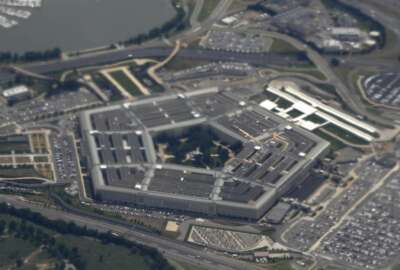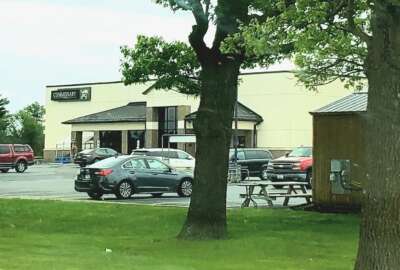
This top-level executive has left the Defense Department, but not the defense industry
Former undersecretary Ellen Lord, who served for the duration of the Trump administration, has joined the Johns Hopkins Applied Physics Laboratory as a senior...
Best listening experience is on Chrome, Firefox or Safari. Subscribe to Federal Drive’s daily audio interviews on Apple Podcasts or PodcastOne.
After four years directing acquisition and sustainment activities in the Pentagon, you change a thing or two. And you learn a thing or two. Now former undersecretary Ellen Lord, who served for the duration of the Trump administration, has joined the Johns Hopkins Applied Physics Laboratory as a senior fellow. She joined Federal Drive with Tom Temin to discuss.
Interview transcript:
Tom Temin: Ms. Lord, good to have you on.
Ellen Lord: Good morning, Tom. And thank you to the Federal News Network for talking about some of my favorite topics.
Tom Temin: Let’s begin with the Applied Physics Laboratory itself. That sounds awfully scientific for someone who is in the business and acquisition and financial sustainment realm at the Pentagon.
Ellen Lord: I actually started my life on the scientific side of things, I have actually a master’s degree in chemistry. So I love all things technical. However, the reason I joined Johns Hopkins Applied Physics Laboratory as a senior fellow is really because they’re solving some of the nation’s most complex national security and space exploration challenges. And I see my expertise at the intersection of national security and industry. So I’m hoping to bring some of that to the lab. They’ve got a great mission. They have an incredible track record of really critical contributions to critical challenges the nation has. And fantastic people, Christine Fox and Ralph Semmel.
Tom Temin: I guess you could also say that some of the great scientific work and great technical work that is done by various agencies and labs and so forth can be undone if the supporting acquisition and sustainment and financial underpinnings aren’t done correctly, a lot of things can be late or things can go wrong. So in many ways, it’s a continuum, isn’t it?
Ellen Lord: Absolutely. First of all, you need the statute to be able to develop a policy. And we worked very closely with Congress on that, they were great partners for us. So we really built on everything and that acquisition professionals had done before we came in about four years ago. And really were focused on trying to very rapidly accelerate innovation in terms of acquisition to field capability to the warfighter at the speed of relevance, as Secretary Mattis would have said.
Tom Temin: Sure, and this took a couple of different forms. One was increased use of other transaction authorities, the OTAs, but also the rewriting. And I guess that’s still underway in some sense of the 5000 series, so called policies for how regular acquisition is done. And that seems like two different difficult things to balance tell us more about the thinking process when those things were happening simultaneously.
Ellen Lord: I think acquisition today in the Department of Defense requires a lot of what I call creative compliance. We obviously always have to do things legally, but we’re asking our acquisition professionals to do a lot of critical thinking, and only use those tools that they need. So we did actually complete the rewrite of the 5000 series. And we transformed it into what we call an adaptive acquisition framework. So there are six different pathways that allow acquisition professionals to most rapidly get programs on contract, whether those be hardware, software, a combination the two, or services, six different pathways, some of which use some of the newer authorities such as other transaction authorities, but also the middle tier of acquisition, where we look at perhaps commercially available systems that only need an incremental investment to really militarize them and make them appropriate for the warfighter. So the whole idea is being creatively compliant and doing things quickly. And all of the service acquisition executives really partnered with us in acquisition and sustainment to make that happen.
Tom Temin: And of course, there’s a large corps of professional contracting officers throughout the many armed services and the fourth estate agencies in the Pentagon. And the bridge between a great new policy well thought out rewrite a lot of industrial involvement. But it takes some doing to get that inculcated down into those acquisition people day to day. And that’s where often a lot of reform founders is on just getting the thinking through the heads of the people that have to carry it out. How would you assess that progress so far?
Ellen Lord: I think that there’s a very good beginning. What we did was work closely with all of the military services and the agencies, as well as industry through the industry associations that we partnered very closely with, so that it was a collaborative approach. Simultaneously, we use the Defense Acquisition University, DAU, to develop a curriculum and really deliver content in different ways to give acquisition professionals experiential learning, if you will. We brought in some of the PEOs and program managers that really embraced the new authorities and use our implementation guidance to really give real life examples of how acquisition professionals could use the new policies. But it’s an ongoing process. And we need to continue to make sure that individuals are given the materials, that they are trained, that it’s not just ethereal policy, but there are actually tools that they can use. And in fact, we really reworked the way DAU delivers content, as well as delivering a new credentialing whole program, where acquisition professionals get those skill sets at the time of need, much more like you would do if you were in the medical or dental industry, and you have ongoing work you do to keep current.
Tom Temin: We’re speaking with former defense undersecretary Ellen Lord, she’s now a senior fellow at the Johns Hopkins Applied Physics Laboratory. And I’m going to talk about the F-35 for a moment and not in the usual way, the ongoing problems that it has. But in many ways it embodied kind of old thinking versus new thinking, tension in the Pentagon, because the Air Force former acquisition fellow Will Roper pushed for a new generation digitally conceived platform, others were pushing to continue and finish the F-35. maturity. And from your standpoint, as the undersecretary, how do you balance that incredible pressure from people that are thinking one way, people that are thinking another way, and nobody’s completely wrong, and yet, you have to do something with respect to budget requests, and future program planning.
Ellen Lord: There are finite budgets available and as we all know, will have flat or declining budgets, even if the DoD budget goes up in absolute dollars a little bit with inflation, it will be coming down. So the challenge that DoD has to address is, what are those threats out there? What are our adversaries doing? And what is the best balance we have in terms of fielding capabilities? Now that’s a challenge given that there are lots of opinions, both on the Hill, as well as in the building, as well as the general public. But I think General CQ Brown has done a very good job of articulating how to look at the tack air mix, which is four plus one. The F-35 performs extremely well, its sustainment costs right now are unacceptable, its operational availability overall is unacceptable. The value for the actual price per airframe today is in the reasonable area, but there is a lot of work to be done. So the challenge becomes with the F-35 at this pivotal moment, how does the department take the joint program office and transition it now to be a little bit more fully integrated with the services and take advantage of all of the learnings over the years that both the Air Force and the Navy have with sustaining their aircraft and keep those unique F-35 issues within the JPO and allow the services to use that incredible sustainment infrastructure they have and all of the talent to address the F-35. There needs to be a balance the F-35 is not only critical to the US Warfighter, but as everyone knows, when the US fights, we don’t fight alone, we go with our partners and allies. And our partners and allies are a very large part of F-35 program. We need to address that and realize that that interoperability is what allows us to prevail in the multi domain battle. So the F-35 is critical, I believe, to our warfighting capability today. And for some time, we do need sixth gen. But the real challenge is the balance between the fifth gen and the sixth gen. We have to make sure that we take all of those investments we’ve made as a nation, and we get a return on that investment with the F-35. And right now, the best way to do that is to get the sustainment costs down.
Tom Temin: Alright. And suppose you had 2-3-4 more years in the job as undersecretary, and if anyone would be able to have the fortitude to do that level job for another four years. What would be the things you would have continued to try to push for? What do you feel might have been left undone, that you wish had gotten a little bit further down the line?
Ellen Lord: I think we’ve made some good progress in a variety of areas. But we need continued focus and energy. One of those would be looking at the cyber threats out there. When we rewrote the acquisition system, we added cybersecurity as a fundamental part of it, both ensuring that the defense industrial base networks were secure through CMMC, or the Cyber Maturity Model certification, which we continue to involve that, in fact, Johns Hopkins APL was a huge part of that, along with Carnegie Mellon University SCI, they were the two organizations I reached out to initially to bring the independent thinking and the technical domain expertise to CMMC. So we need to continue the push on that, industry has embraced it, making good progress. We continue to need to make sure that we cyber harden all of the new platforms and weapon systems moving, so that’s one area. Secondly, we did a lot of work in terms of acknowledging that our platforms and weapon systems are hardware enabled, yet software defined. And we need to make sure that we rapidly update software as it’s developed. So we really leverage some of the great resources that the department has with the Defense Science Board, with the Defense Innovation Board. And we studied software, and we came up with a number of recommendations, how to deal with software differently than hardware. We partnered with Congress and we have pathfinder projects, looking at a software color of money, where you really can’t differentiate if you’re embracing agile and DevSecOps, between development, production and sustainment of software. So I want to see those pathfinder projects finished and I want to see further incorporation. I also want to make sure that we continue to embrace digital engineering. That is the key to the future in my mind. The Navy did a great job in terms of sustainment, looking at digital engineering in their shipyards to be able to make sure that they were able to repair different ships. What we need to do is make sure that digital engineering is a fundamental tenet of all programs going forward. The Air Force has ground based strategic deterrent, I think, as a poster child for digital engineering, a very, very strong PEO there. Again, interestingly enough that PEO did a year at Johns Hopkins Applied Physics Lab and learned a lot of what he applied to GBSD there. So digital engineering not only gives you the security, but it gives you the ability to have everything in one cloud where instead of fat fingering powerpoints or gate reviews, you just go right in and look at what’s being done, so it gives you speed. So those are some of the things that I would continue working on. And I’m so very excited that Mike Brown has been nominated as undersecretary for acquisition and sustainment. He’s bringing just the type of talent and experience that we need to that position. He used over 50 I think it was OTA contracts at DIU. He understands commercial companies., and our real challenge is to diversify that defense industrial base and get more non-traditionals in there, more commercial companies. And I think Mike Brown is the guy to do it.
Tom Temin: And you of course earlier in your career worked for a couple of large defense contractors, and now you’re on different boards and advisory groups and so forth, where you will be possibly advising defense contractors. What would your main message to them be now in this new age of agile acquisition, agile software development, software definition and all of this to be great contractors?
Ellen Lord: They need to embrace digital engineering, they need to address cybersecurity threats, and they need to move quickly to take commercial offerings out there today and tweak them to make them relevant for the Department of Defense. I think the area where this is most applicable is space, where we have so many new space companies, so much innovation, we have space as the newest warfighting domain. General Raymond is doing I think extraordinary things and embracing new acquisition techniques. He’s got the right spirit in terms of what he is trying to do. And I think we need enhanced dialogue between industry and government to make sure we really embrace all of the inventions, innovation, and actual applications that the commercial space industry has come up with to our national security interests. Because frankly, in space, things are a little blurred between what’s commercial, what’s national security, what’s offensive, what’s defensive, we need to think through that very carefully.
Tom Temin: Former Defense Undersecretary Ellen Lord is a senior fellow at the Johns Hopkins Applied Physics Laboratory. Thanks so much for joining me.
Ellen Lord: Thank you, Tom. And thank you again to Federal News Network.
Copyright © 2025 Federal News Network. All rights reserved. This website is not intended for users located within the European Economic Area.
Tom Temin is host of the Federal Drive and has been providing insight on federal technology and management issues for more than 30 years.
Follow @tteminWFED






